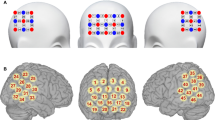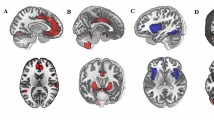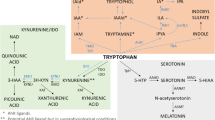Abstract
The present study examines relationships between regional brain chemistry (as identified by localized in vivo three-dimensional single-voxel proton magnetic resonance spectroscopy (1H-MRS) and anxiety (as measured by the State-Trait Anxiety Inventory) in 16 healthy subjects. The relative concentrations of N-Acetyl aspartate, choline, glutamate, glutamine, γ-aminobutyric acid, inositol, glucose and lactate were measured relative to creatine within six 8-cm3 brain voxels localized to: thalamus, cingulate, insula, sensorimotor, dorsolateral prefrontal, and orbital frontal cortices (OFC) in the left hemisphere. Analysis of variance, across brain regions, chemicals, and high and low anxiety groups, showed a relationship between anxiety and chemical composition of OFC, with high anxiety subjects demonstrating 32% increase in overall chemical concentrations within OFC, as compared to the lower anxiety group (F = 60.8, P < 10−7). Other brain regions, including cingulate, showed no detectable anxiety dependence. The combination of the state and trait anxiety was highly correlated with the concentration of OFC chemicals (r2 = 0.98), and N-Acetyl aspartate in OFC was identified as the strongest chemical marker for anxiety (changed by 43.2% between the two anxiety groups, F = 21.5, P = 0.000005). The results provide direct evidence that the OFC chemistry is associated with anxiety in healthy humans. The method can be used as a neuroimaging/behavioral tool for documentation of OFC chemistry changes in relation to anxiety per se and anxiety disorders. The presented relationship between regional brain chemistry and anxiety reflects the functional/behavioral state of the brain, pointing to possible mechanisms of the neurobiology of anxiety.
This is a preview of subscription content, access via your institution
Access options
Subscribe to this journal
Receive 12 print issues and online access
$259.00 per year
only $21.58 per issue
Buy this article
- Purchase on Springer Link
- Instant access to full article PDF
Prices may be subject to local taxes which are calculated during checkout




Similar content being viewed by others
References
Kessler RC, McGonagle KA, Zhao S, Nelson CB, Hughes M, Eshleman S et al. Lifetime and 12-month prevalence of DSM-III-R psychiatric disorders in the United States. Results from the National Comorbidity Survey Arch Gen Psychiatry 1994; 51: 8–19
Magee WJ, Eaton WW, Wittchen HU, McGonagle KA, Kessler RC . Agoraphobia, simple phobia, and social phobia in the National Comorbidity Survey Arch Gen Psychiatry 1996; 53: 159–168
Weissman MM, Bland RC, Canino GJ, Faravelli C, Greenwald S, Hwu HG et al. The cross-national epidemiology of panic disorder Arch Gen Psychiatry 1997; 54: 305–309
Anagnostaras SG, Craske MG, Fanselow MS . Nat Neurosci 1999; 2: 780–782
Connor KM, Davidson JRT . Generalized anxiety disorder: neurobiological and pharmacotherapeutic perspectives Biol Psychiatry 1998; 44: 1286–1294
Coplan JD, Lydiard RB . Brain circuits in panic disorder Biol Psychiatry 1998; 44: 1264–1276
Barchas JD, Altemus M . Biochemical hypotheses of mood and anxiety disorders. In: Siegel GJ, Agranoff BW, Albers RW, Fisher SK, Uhler MD (eds) Basic Neurochemistry: Molecular, Cellular and Medical Aspects, 6th edn Lippincott-Raven Publishers: Philadelphia 1999; pp1073–1093
Ninan PT . The functional anatomy, neurochemistry, and pharmacology of anxiety J Clin Psychiatry 1999; 60: 12–17
Davidson RJ, Abercrombie H, Nitschke JB, Putnam K . Regional brain function, emotion and disorders of emotion Curr Opin Neurobiol 1999; 9: 228–234
Baxter LR Jr, Schwartz JM, Mazziotta JC, Phelps ME, Pahl JJ, Guze BH et al. Cerebral glucose metabolic rates in nondepressed patients with obsessive-compulsive disorder Am J Psychiatry 1988; 145: 1560–1563
Nordahl TE, Benkelfat C, Semple WE, Gross M, King AC et al. Cerebral glucose metabolic rates in obsessive compulsive disorder Neuropsychopharmacology 1989; 2: 23–28
Swedo SE, Schapiro MB, Grady CL, Cheslow DL, Leonard HL, Kumar A et al. Cerebral glucose metabolism in childhood-onset obsessive-compulsive disorder Arch Gen Psychiatry 1989; 46: 518–523
Rauch SL, Jenike MA, Alpert NM, Baer L, Breiter HC, Savage CR et al. Regional cerebral blood flow measured during symptom provcation in obsessive-compulsive disorder using oxygen 15-labeled carbon dioxide and positron emission tomography Arch Gen Psychiatry 1994; 51: 62–70
Breiter HC, Rauch SL, Kwong KK, Baker JR, Weisskoff RM, Kennedy DN et al. Functional magnetic resonance imaging of symptom provocation in obsessive-compulsive disorder Arch Gen Psychiatry 1996; 53: 595–606
Javanmard M, Shlik J, Kennedy SH, Vaccarino FJ, Houle S, Bradwejn J . Neuroanatomic correlates of CCK-4-induced panic attacks in healthy humans: a comparison of two time points Biol Psychiatry 1999; 45: 872–882
Kimbrell TA, Georg MS, Parekh PI, Ketter TA, Podeli DM, Danielson AL et al. Regional brain activity during transient self-induced anxiety and anger in healthy adults Biol Psychiatry 1999; 46: 454–465
Dager SR, Marro KI, Richards TL, Metzger GD . Preliminary application of magnetic resonance spectroscopy to investigate lactate-induced panic Am J Psychiatry 1994; 151: 57–63
Dager SR, Richards T, Strauss W, Artru A . Single-voxel 1H-MRS investigation of brain metabolic changes during lactate-induced panic Psychiatry Res 1997; 76: 89–99
Dager SR, Friedman SD, Heid A, Layton ME, Richards T, Artru A et al. Two-dimensional proton echo-planar spectroscopic imaging of brain metabolic changes during lactate-induced panic Arch Gen Psychiatry 1999; 56: 70–77
Grachev ID, Apkarian AV . Chemical heterogeneity of the living human brain: a proton MR spectroscopy study on the effects of sex, age and brain region NeuroImage 2000; 11: 554–563
Talairach J, Tournoux P . Co-planar Stereotactic Atlas of the Human Brain. 3-Dimensional Proportional System: an Approach to Cerebral Imaging Thieme: Stuttgart 1988
Grachev ID, Berdichevsky D, Rauch SL, Heckers S, Kennedy DN, Caviness VS, Alpert NM . A method for assessing the accuracy of intersubject registration of the human brain using anatomic landmarks NeuroImage 1999; 9: 250–268
Michaelis T, Merboldt KD, Bruhn H, Hanicke W, Frahm J . Absolute concentrations of metabolites in the adult human brain in vivo: quantification of localized proton MR spectra Radiology 1993; 187: 219–227
Salibi N, Brown MA . Clinical MR Spectroscopy: First Principles Wiley-Liss: Toronto 1998
Simmons A, Smail M, Moore E, Williams SCR . Serial precision of metabolite peak area ratios and water referenced metabolite peak areas in proton MR spectroscopy of the human brain Magn Reson Imaging 1998; 16: 319–330
Spielberger CD, Gorsuch RL, Lushene R, Vagg PR, Jacobs GA . Manual for the State-Trait Anxiety Inventory Consulting Psychologists Press: Palo Alto CA 1983
Rauch SL, Savage CR, Alpert NM, Miguel EC, Baer L, Breiter HC et al. A positron emission tomographic study of simple phobic symptom provocation Arch Gen Psychiatry 1995; 52: 20–28
Rauch SL, van der Kolk BA, Fisler RE, Alpert NM, Orr SP, Savage CR et al. A symptom provocation study of posttraumatic stress disorder using positron emission tomography and scriptdriven imagery Arch Gen Psychiatry 1996; 53: 380–387
Benkelfat C, Bradwejn J, Meyer E, Ellenbogen M, Milot S, Gjedde A et al. Functional neuroanatomy of CCK4-induced anxiety in normal healthy volunteers Am J Psychiatry 1995; 152: 1180–1184
Rainville P, Duncan GH, Price DD, Carrier B, Bushnell MC . Pain affect encoded in human anterior cingulate but not somatosensory cortex Science 1997; 277: 968–971
Bush G, Whalen PJ, Rosen BR, Jenike MA, McInerney SC, Rauch SL . The counting Stroop: an interference task specialized for functional neuroimaging—validation study with functional MRI Hum Brain Mapp 1998; 6: 270–282
Whalen PJ, Bush G, McNally RJ, Wilhelm S, McInerney SC, Jenike MA et al. The emotional counting Stroop paradigm: a functional magnetic resonance imaging probe of the anterior cingulate affective division Biol Psychiatry 1998; 44: 1219–1228
Peyron R, Garcia-Larrea L, Gregoire MC, Costes N, Convers P, Lavenne F et al. Haemodynamic brain responses to acute pain in humans: sensory and attentional networks Brain 1999; 122: 1765–1779
Bechara A, Damasio AR, Damasio H, Anderson SW . Insensitivity to future consequences following damage to human prefrontal cortex Cognition 1994; 50: 7–15
Bechara A, Damasio H, Tranel D, Damasio AR . Deciding advantageously before knowing the advantageous strategy Science 1997; 275: 1293–1295
Bechara A, Damasio H, Tranel D, Anderson SW . Dissociation of working memory within the human prefrontal cortex J Neurosci 1998; 18: 428–437
Damasio AR . The somatic marker hypothesis and the possible functions of the prefrontal cortex. In: Roberts AC, Robbins TW, Weiskrantz L (eds) The Prefrontal Cortex: Executive and Cognitive Functions Oxford University Press: New York 1998; pp36–50
Malizia AL, Cunningham VJ, Bell CJ, Liddle PF, Jones T, Nutt DJ . Decreased brain GABA(A)-benzodiazepine receptor binding in panic disorder: preliminary results from a quantitative PET study Arch Gen Psychiatry 1998; 55: 715–720
Crestani F, Lorez M, Baer K, Essrich C, Benke D, Laurent JP et al. Decreased GABAA-receptor clustering results in enhanced anxiety and a bias for threat cues Nat Neurosci 1999; 2: 833–839
Miller BL . A review of chemical issues in 1H NMR spectroscopy: N-acetyl-L-aspartate, creatine, and choline NMR Biomed 1991; 4: 47–52
Gruetter R, Novotny EJ, Boulware SD, Rothman DL, Shulman RG . 1H NMR studies of glucose transport in the human brain J Cereb Blood Flow Metab 1996; 16: 427–438
Shulman RG, Rothman DL . Interpreting functional imaging studies in terms of neurotransmitter cycling Proc Natl Acad Sci USA 1998; 95: 11993–11998
Sibson NR, Dhankhar A, Mason GF, Rothman DL, Behar KL, Shulman RG . Stoichiometric coupling of brain glusose metabolism and glutamatergic neuronal activity Proc Natl Acad Sci USA 1998; 95: 316–321
Magistretti PJ, Pellerin L, Rothman DL, Shulman RG . Energy on demand Science 1999; 283: 496–497
Grachev ID, Breiter HC, Rauch SL, Savage CR, Baer L, Shera DM et al. Structural abnormalities of frontal neocortex in obsessive-compulsive disorder Arch Gen Psychiatry 1998; 55: 181–182
Acknowledgements
We would like to thank S Huckins for technical assistance and P Sheehe for discussions of data analysis. The project was funded by NIH/NINDS NS35115 and Department of Neurosurgery at SUNY Upstate Medical University.
Author information
Authors and Affiliations
Corresponding author
Rights and permissions
About this article
Cite this article
Grachev, I., Apkarian, A. Anxiety in healthy humans is associated with orbital frontal chemistry. Mol Psychiatry 5, 482–488 (2000). https://doi.org/10.1038/sj.mp.4000778
Received:
Revised:
Accepted:
Published:
Issue Date:
DOI: https://doi.org/10.1038/sj.mp.4000778
Keywords
This article is cited by
-
The role of mid-insula in the relationship between cardiac interoceptive attention and anxiety: evidence from an fMRI study
Scientific Reports (2018)
-
Brain metabolite abnormalities in ventromedial prefrontal cortex are related to duration of hypercortisolism and anxiety in patients with Cushing’s syndrome
Endocrine (2016)
-
Acute Shift in Glutamate Concentrations Following Experimentally Induced Panic with Cholecystokinin Tetrapeptide—A 3T-MRS Study in Healthy Subjects
Neuropsychopharmacology (2013)
-
The patient’s anxiety before seeing a doctor and her/his hospital choice behavior in China
BMC Public Health (2012)
-
Relevance of orbitofrontal neurochemistry for the outcome of cognitive-behavioural therapy in patients with obsessive–compulsive disorder
European Archives of Psychiatry and Clinical Neuroscience (2012)



